Do you have a question about the NuAire LabGard E NU-543-300 and is the answer not in the manual?
Describes the cabinet's features, purpose, and compliance with standards.
Explains warning and hazard symbols used throughout the manual.
Outlines steps for dealing with damaged goods upon receipt.
Advises on optimal placement and clearances for the biosafety cabinet.
Details how to assemble the base stand for the cabinet.
Explains how to properly level the biosafety cabinet.
Instructions for installing the cabinet on a laboratory bench.
Discusses precautions and recommendations for using gas service.
Describes cabinet plumbing connections and valve usage.
Covers power requirements, connections, and circuit protection.
Final steps before operation, including initial cleaning.
Introduces the FlowGard system for cabinet control and monitoring.
Describes the FlowGard system's functions and components.
Details the functions of the control panel keys and LEDs.
Explains the power-up sequence and behavior during interruptions.
Describes the cabinet's state when not in active use.
Explains the operational mode with warm-up and display.
Details the mode for continuous filtering at reduced speed.
Describes how alarms are presented in different modes.
Access and navigation for user settings.
How to move through the menu system.
Setting time of day and auto timers.
Explains timer functions for lights and outlets.
Tracking and resetting UV lamp usage.
How temperature is displayed and adjusted.
Setting a password for blower operation.
Defines the safe work zone within the cabinet.
Techniques to maintain airflow integrity.
Impact of room activity on airflow.
Principles of airflow within the cabinet.
Best practices for aseptic work.
Start-up, cleaning, and air purging procedures.
How to place and arrange items within the cabinet.
Guidelines for actual work procedures.
Post-work procedures for purging and disinfecting.
Maintenance of the paper catch.
Procedures for turning off the unit.
General cleaning advice.
PPE and preparation for decontamination.
Steps for performing the decontamination.
Reassembly after decontamination.
Procedures for cabinet decontamination.
Step-by-step manual decontamination process.
Using automated decontamination systems.
Details of the decontamination cycle.
Post-decontamination aeration steps.
General steps for filter/motor replacement.
Specific steps for removing HEPA filters.
Overview of airflow calibration.
Settings for airflow control.
Specific steps for downflow calibration.
Specific steps for inflow calibration.
Adjusting sensor readings.
Verifying alarm setpoints.
Methods for downflow velocity measurement.
Methods for inflow velocity measurement.
Alternative inflow measurement method.
Leak testing the supply filter.
Leak testing the exhaust filter.
Visualizing airflow with smoke.
Tests for alarms and connections.
Testing the sash position alarm.
Testing airflow/pressure alarms.
Assessing exhaust transitions.
Steps to replace the board.
Replacing fuses on the board.
Resetting the control board.
Info on the airflow sensor.
Table of error messages and corrections.
Synchronizing functions with blower operation.
Various functional settings.
Settings related to blower operation.
Configuring auto decontamination.
Details on the fan relay contacts.
Details on the alarm relay contacts.
Information on the 15VDC output.
Information about the UV light.
Description of UV light purpose.
How to operate the UV light.
Safety precautions for UV light.
Covers voltage, current, and supply fluctuations.
Details performance, light, pollution, and EMC.
Guidelines for chemical compatibility during cleaning.
Lists cabinet components and their materials.
Steps to remove the control center.
Steps to remove the front panel.
Wiring diagram of the cabinet.
Part list for the electrical schematic.
Describes the cabinet's features, purpose, and compliance with standards.
Explains warning and hazard symbols used throughout the manual.
Outlines steps for dealing with damaged goods upon receipt.
Advises on optimal placement and clearances for the biosafety cabinet.
Details how to assemble the base stand for the cabinet.
Explains how to properly level the biosafety cabinet.
Instructions for installing the cabinet on a laboratory bench.
Discusses precautions and recommendations for using gas service.
Describes cabinet plumbing connections and valve usage.
Covers power requirements, connections, and circuit protection.
Final steps before operation, including initial cleaning.
Introduces the FlowGard system for cabinet control and monitoring.
Describes the FlowGard system's functions and components.
Details the functions of the control panel keys and LEDs.
Explains the power-up sequence and behavior during interruptions.
Describes the cabinet's state when not in active use.
Explains the operational mode with warm-up and display.
Details the mode for continuous filtering at reduced speed.
Describes how alarms are presented in different modes.
Access and navigation for user settings.
How to move through the menu system.
Setting time of day and auto timers.
Explains timer functions for lights and outlets.
Tracking and resetting UV lamp usage.
How temperature is displayed and adjusted.
Setting a password for blower operation.
Defines the safe work zone within the cabinet.
Techniques to maintain airflow integrity.
Impact of room activity on airflow.
Principles of airflow within the cabinet.
Best practices for aseptic work.
Start-up, cleaning, and air purging procedures.
How to place and arrange items within the cabinet.
Guidelines for actual work procedures.
Post-work procedures for purging and disinfecting.
Maintenance of the paper catch.
Procedures for turning off the unit.
General cleaning advice.
PPE and preparation for decontamination.
Steps for performing the decontamination.
Reassembly after decontamination.
Procedures for cabinet decontamination.
Step-by-step manual decontamination process.
Using automated decontamination systems.
Details of the decontamination cycle.
Post-decontamination aeration steps.
General steps for filter/motor replacement.
Specific steps for removing HEPA filters.
Overview of airflow calibration.
Settings for airflow control.
Specific steps for downflow calibration.
Specific steps for inflow calibration.
Adjusting sensor readings.
Verifying alarm setpoints.
Methods for downflow velocity measurement.
Methods for inflow velocity measurement.
Alternative inflow measurement method.
Leak testing the supply filter.
Leak testing the exhaust filter.
Visualizing airflow with smoke.
Tests for alarms and connections.
Testing the sash position alarm.
Testing airflow/pressure alarms.
Assessing exhaust transitions.
Steps to replace the board.
Replacing fuses on the board.
Resetting the control board.
Info on the airflow sensor.
Table of error messages and corrections.
Synchronizing functions with blower operation.
Various functional settings.
Settings related to blower operation.
Configuring auto decontamination.
Details on the fan relay contacts.
Details on the alarm relay contacts.
Information on the 15VDC output.
Information about the UV light.
Description of UV light purpose.
How to operate the UV light.
Safety precautions for UV light.
Covers voltage, current, and supply fluctuations.
Details performance, light, pollution, and EMC.
Guidelines for chemical compatibility during cleaning.
Lists cabinet components and their materials.
Steps to remove the control center.
Steps to remove the front panel.
Wiring diagram of the cabinet.
Part list for the electrical schematic.
| Brand | NuAire |
|---|---|
| Model | LabGard E NU-543-300 |
| Category | Laboratory Equipment |
| Language | English |
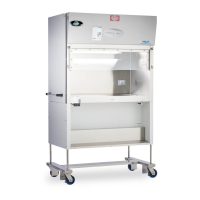
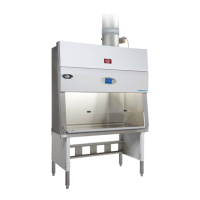

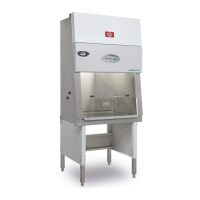
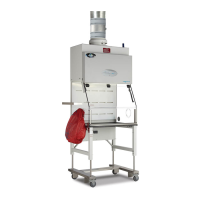
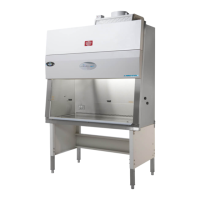


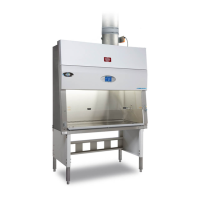



